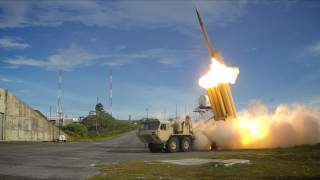THAAD Won't Save Asia (or America) from North Korea
But it could make things worse.
Last week U.S. officials confirmed that the Terminal High Altitude Area Defense (THAAD) missile defense battery deployed on a South Korean golf course reached initial operating capability. As tensions grow on the Korean peninsula, THAAD’s deployment is supposed to improve deterrence by bolstering the ability of the United States and South Korea to defend against North Korean ballistic missiles.
While THAAD does reduce the chances of a successful North Korean missile attack against important U.S. military bases and some South Korean cities, it probably won’t do much to cool down the situation on the peninsula. In fact, THAAD could contribute to instability and increase the likelihood of a crisis.
Why is that? First, it is important to understand what the THAAD system is and isn’t capable of doing.
THAAD is not able to defend Seoul from North Korean missiles because most of the capital city is just outside the 200 km range of THAAD’s interceptors. While not in a position to defend Seoul, THAAD could protect several locations that are essential for conducting sustained combat operations against North Korea, such as the port of Busan and Kunsan air base. Moreover, even if THAAD were deployed closer to Seoul, it would not be able to defend against the conventional artillery threat to the city.
Critically, THAAD would not be able to shoot down a North Korean missile test or an intercontinental ballistic missile (ICBM) heading for the U.S. homeland. THAAD can only engage missiles as they fall back down to earth. If a missile is falling within the engagement range of THAAD’s interceptors, then North Korea is not testing a missile, it is attacking South Korea.
It will not work for U.S. homeland defense, either. The only thing capable of defending the continental U.S. from ICBMs is the Ground-Based Midcourse Defense (GMD) system, which has a spotty testing record. While THAAD could not shoot down an ICBM, its radar could provide targeting data to the GMD to improve the chance of a successful intercept, but that is hardly a guarantee of success.
With these technical limitations in mind, THAAD’s main purpose is to provide a protective umbrella for U.S. air force bases in South Korea, and the port of Busan, the primary port of entry for follow-on U.S. ground forces in the event of a long-term fight with North Korea.
But although missile defense systems are usually viewed as solely defensive, the protection they provide also creates a perverse incentive for U.S. military planners to use force offensively. If U.S. planners believe essential military facilities are relatively safe from missile attack, they could be emboldened to launch first strikes against North Korea’s nuclear forces.
Currently, the United States, South Korea, and North Korea all face strong incentives to go first in a conflict. The best way for the United States and South Korea to limit the damage of a North Korean attack is to destroy the North’s nuclear weapons on the ground or kill Kim Jong Un before he can give the order. Unfortunately, this also places Kim Jong Un in a “use it or lose it” position to attack first with his nuclear weapons in the hope of short-circuiting a disarming attack.
Before THAAD, a disarming blow was incredibly risky because of the damage that just a few surviving nuclear-armed missiles could do to U.S. forces in South Korea. The risk and danger of a disarming strike are both still high, but THAAD does reduce them by providing a better shield against any weapons that may survive the first strike.
Ultimately, THAAD will do little to defuse the current tensions on the Korean peninsula. The greater protection it provides to U.S. troops could make U.S. escalation less costly and therefore more attractive. The Trump administration will have to find another way out of this crisis.
Eric Gomez is a policy analyst for defense and foreign policy studies at the Cato Institute.
This first appeared in RealClearDefense here.

